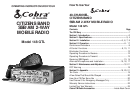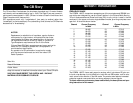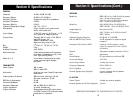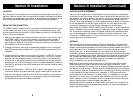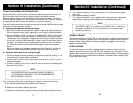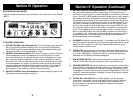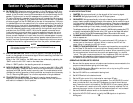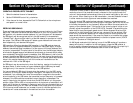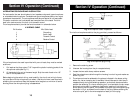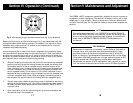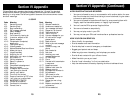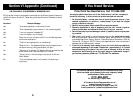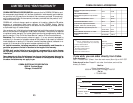
Section IV Operation (Continued)
B. INDICATOR FUNCTIONS
1. S-METER. Swings proportionally to the strength of the incoming signal.
2. RF METER. Swings proportionally to the RF output power.
3. SWR METER. Swings proportionally to the ratio of standing wave voltage and RF
output. Used to properly adjusts the length of the antenna, and to monitor the qual-
ity of the coaxial cable and all RF electrical connections. If there is any degradation
whatsoever in any of the above, due to humidity, salt, spray, vibration or corrosion,
the SWR meter reading will rise, thereby indicating that a problem exists.
To calibrate, switch to the “CAL” position, transmit in AM Mode by pressing the (PTT)
mic switch, and adjust the SWR control to the “CAL” mark on the meter then switch
to “SWR” position for the SWR measurement (Note: CB must be in AM mode).
4. CHANNEL INDICATOR. Numbered LED indicates the selected channel you
wish to operate on.
5. RECEIVE/TRANSMIT INDICATOR. The receiver/transmit LED indicator is
located next to the channel indicator. When in receive, the LED will be
green. When in transmit the LED will be red.
6. PRESS-TO-TALK MICROPHONE. The receiver and transmitter are controlled
by the Press-To-Talk switch on the microphone. Press the switch and the
transmitter is activated, release the switch to receive. When transmitting, hold
the microphone two inches from the mouth and speak clearly in a normal
“voice”. The radio comes complete with low-impedance (500 ohm) dynamic
microphone. For installation instructions on the other microphones see
ALTERNATE MICROPHONES AND INSTALLATION section.
OPERATING PROCEDURE TO RECEIVE
1. Be sure that the power source, microphone and antenna are connected to the
proper connectors before going to the next step.
2. Set PA-CB Switch to the CB position and turn unit on by turning VOL control
clockwise on COBRA 148GTL.
3. Set the VOLUME for a comfortable listening level.
4. Set MODE switch to the desired mode.
5. Set the RF gain control fully clockwise for maximum RF gain.
6. Listen to the background noise from the speaker. Turn the SQUELCH control
slowly clockwise until the noise JUST disappears (no signal should be pre-
sent). Leave the control at this setting. The SQUELCH is now properly adjust-
ed. The receiver will remain quiet until a signal is actually received. Do not
advance the control too far, or some of the weaker signals will not be heard.
7. Set the CHANNEL selector switch to the desired channel.
8. Adjust the VOICE LOCK control to clarify the SSB signals or to optimize
AM signals.
12
11
Section IV Operation (Continued)
10. PA/CB SWITCH. Selects the mode of operation. In the CB position, the PA func-
tion is disabled and the unit will transmit and receive on the speaker that is con-
nected. In the PA mode, incoming CB transmission will be heard through the PA
speaker. This allows you to monitor messages while outside of your vehicle.
To use the PA feature, a speaker having a voice coil impedance of 8 ohms and
a power handling capability of at least three watts should be used. This speaker
must be plugged into the PA SPKR jack at the rear of the transceiver. If the pub-
lic address feature is to be used primarily for outdoor applications, the use of a
weatherproof horn type public address speaker is recommended. The durability
of this type speaker plus the inherent efficiency of such a speaker will provide
more than adequate results when combined with the high audio output level
available from the COBRA 148GTL. With the PA speaker connected as out-
lined previously, be sure that there is physical separation between the micro-
phone and the speaker itself. If the speaker is located too close to the micro-
phone, acoustic feedback will result when the public address system is operat-
ed at high volume. A directional type outdoor speaker reduces the amount of
isolation required. Some experimentation will determine the minimum amount
of isolation required for a given sound level from the public address system.
NOTE
PA volume is controlled by adjusting the DYNAMIKE knob to
the desired volume.
11. S-RF/CAL/SWR SWITCH. When in the S-RF position, the meter swings propor-
tionally to the strength of the received signal. When transmitting, the meter indi-
cates relative RF output power.
When in the “CAL” position, the SWR meter can be calibrated by adjusting the
“SWR” control to the “CAL” mark on the meter face.
When in “SWR” position, the standing wave ratio is measured.
12. MODE (LSB/AM/USB) SWITCH. This switch is used to select AM, LSB or USB
mode of operation. Unless the station with which communication is desired is
equipped with SSB, the AM mode is normally used. The mode selector switch
changes the mode of operation of both transmitter and receiver simultaneously.
Turn to “Receiving SSB signals” for a further explanation of single sideband.
13. TONE SWITCH-HI/NOR/LOW. This switch is used to shape the audio
response to the operator’s preference. Bass is increased in the LOW position
and treble is increased in the HI position.



